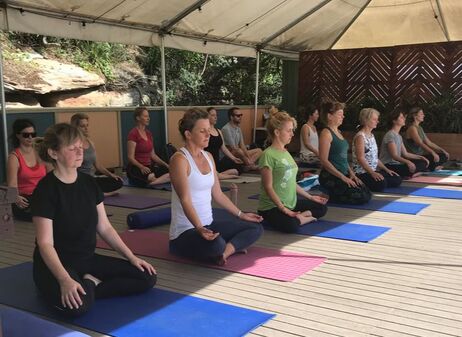|
What if we could use the power of our breath to transform our overactive, high-energy mind into a more relaxed and calm state of being - releasing unwanted emotions? Our bodies are programmed to easily access our flight-or-fight state response system, also known as an acute stress response. This release of hormones triggers our sympathetic nervous system to RESPOND! A characteristic that helped homosapiens survive predators, but in the modern era, sometimes this response is often triggered by things that are not life or death situations. We are programmed from a young age to keep our eyes on the future and our goals, always moving forward. However, this constant need to move fast has caused a society full of stressed out, overworked individuals, and too many shallow breathers. As humans, when we enter an uneasy situation, our blood pressure rises and we subconsciously begin to enter our flight-or-fight mode. Our heart rate increases, our chest tightens, and without even realizing it we are breathing from the chest- shallow and quick. This shallow breathing essentially feeds into our overwhelming emotions offering zero assistance in calming our nerves. Panic rises and a foggy mind presents itself, hindering our ability to look at a situation with logic. A calm, deep breath, and control over it, is needed to keep relative balance within the mind and body. But how do we tap into the power of our breath before we enter into our fight-or-flight state? To activate our more calm side, we need to utilize our entire diaphragm while controlling our breath in order to tap into our rest-and-digest, or parasympathetic response. The belly must rise with every inhale and it must fall with every exhale, completely. To activate the parasympathetic nervous system, our calm state of being, our exhales must extend longer than our inhales. It is through our exhales we learn to let go and we truly feel that sensation of release. Taking control of our breath takes work and can seem like a full-time job. At first, it takes a lot of conscious thinking and doing to establish a habit like deep breathwork. It will be challenging, but if you start small, like within your yoga practice, you will find that the tools you learn on your mat will only naturally carry with you when you venture off of your mat. To understand our breath, we must first spend some time with it. Truly listen to the breathing patterns throughout the day. Carry a journal with you, take notes of how you feel during certain situations and the way you are breathing during them. We cannot control something we do not fully understand, so make friends with your breath. The more you sit with your breath, the easier it will become to navigate through your daily emotions. Anxiety cannot fully present itself if we are breathing completely, not just from the chest. Below are a few breathing techniques we can use to help establish more breath and body awareness within our daily lives. 1. 3-Part Yogic BREATH This simple breathing technique will be your go to during any moments of sadness, anger, anxiety, excitement, etc. I suggest beginning each morning with at least 3-5 minutes of deep belly breathing. Find a comfortable spot. Ideally, you want to be able to close your eyes, however, this technique can be performed at any time and anywhere. Relax the shoulders away from the ears and lengthen through the crown of the head. Take a deep inhale through the nose and notice how the belly rises, the ribs expand to the sides, and the chest lifts. Exhale slowly, yet forcefully out of the mouth. Notice every sensation. Repeat. Focus on nothing but the rhythm of the breath. The way it feels as it flows into your body and the way it feels as you release and let it go. Your breath is your anchor. Familiarize yourself with it, you’re here to make friends with it. Optional Variations:
How to do it: Nadhi sodhana can be done seated or lying down. To start, empty all the air from your lungs. Using the thumb of your dominant hand, block your right nostril and inhale through your left nostril only. Be sure to inhale into your belly, not your chest. Once you are full of breath, seal your left nostril with the ring finger of the same hand, keeping your right nostril closed, and hold the breath for a moment. Then release your thumb and exhale through your right nostril only. Be sure to exhale all the breath out of the right side and pause before inhaling again through the same side. Seal both nostrils once you’ve inhaled on the right side and exhaled through the left side. A complete cycle of breath includes an inhalation and exhalation through both nostrils. If you’re just starting out, you can do a four-count inhale, holding your breath for four to eight counts, then exhale for four counts. Perform up to ten cycles and notice how your body responds. You may feel more relaxed and calm in both your mind and body. 3. UJJAYI PRANAYAMA (OCEAN | VICTORIOUS BREATH)“You and I are all as much continuous with the physical universe as a wave is continuous with the ocean.” ~ Alan Watts Ocean breath is a very calming, yet energizing technique primarily used while holding asanas (poses) Ujjayi has a balancing influence on the entire cardiorespiratory system, releases feelings of irritation and frustration, and helps calm the mind and body How to do it: Close your lips and start to take sow, long, active inhales through your nose. Take an inhalation through your nose that is slightly deeper than normal. While contracting the muscles in the back of your throat, exhale slowly through your nose. Simple breath awareness is an excellent meditation technique. As you breathe consciously through the nose, recall that this magnificent function has been with you since the moment of your birth and will be with you until your final exhale of this precious life. HELPFUL TIPS FOR GETTING STARTED
SOURCES:https://www.artofliving.org/us-en/yoga/breathing-techniques/yoga-and-pranayama Asana, Pranayama, Mudra, Bandha. Saraswati. Bihar School of Yoga. 1999 Information from article by Joella Erin
0 Comments
Your comment will be posted after it is approved.
Leave a Reply. |
AuthorDaniella Goldberg has a love of yoga and a passion for mindful meditation. Through her Hatha-Flow classes, she gently guides her students to grow strong, be flexible, focused and mindful, on and off the mat. Archives
October 2023
Categories |
© 2022 This material is protected by copyright under the laws of Australia and may not be used without written permission by Yogarama.


 RSS Feed
RSS Feed